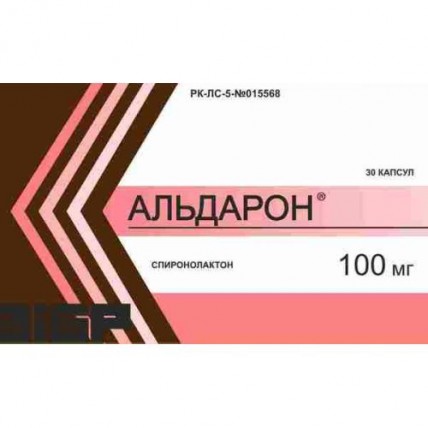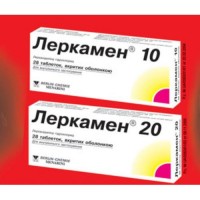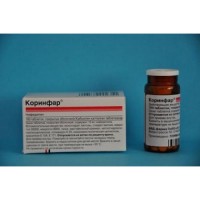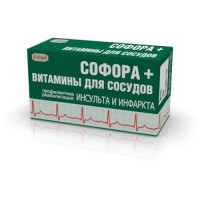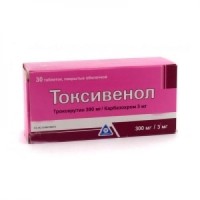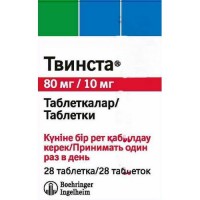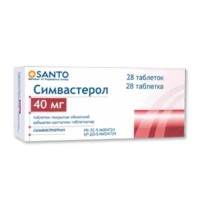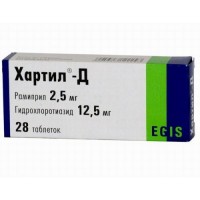Aldaron 100 mg (30 capsules)
- $16.80
The instruction for medical use of Aldaron® medicine the Trade name of Aldaron® the International unlicensed name Spironolactonum Dosage Form of the Capsule of 50 mg, 100 mg Structure One capsule contains active agent - Spironolactonum of 50.0 mg or 100.0 mg, excipients: lactoses monohydrate, cellulose microcrystalline, magnesium stearate, silicon dioxide colloidal anhydrous. structure of capsule 1 (for a dosage of 50 mg) the body: titan dioxide (E171), gelatin lid: the titan dioxide (E171), gelatin, Diamond blue FCF (E133), Crystal violet structure of capsule 2 (for a dosage of 50 mg) the body: the titan dioxide (E 171), gelatin, sodium lauryl sulfate, water the cleaned lid: Carmoisin (E 122), the titan dioxide (E171), gelatin, sodium lauryl sulfate, the water purified FD&C Blue No. 2 structure of capsule 1 (for a dosage of 100 mg) the body: FD&C Red No. 40 (E129), D&C Red No. 33, FD&C Yellow No. 6 (E110), D&C Yellow No. 10 (E104), titan dioxide (E171), gelatin lid: FD&C Red No. 40 (E129), D&C Red No. 33, FD&C Yellow No. 6 (E110), D&C Yellow No. 10 (E104), the titan dioxide (E171), gelatin structure of capsule 2 (for a dosage of 100 mg) the body: the titan dioxide (E 171), gelatin, sodium lauryl sulfate, water purified FD&C Red No. 40 (E 129), Karmuazin (E 122) a lid: Carmoisin (E 122), the titan dioxide (E171), gelatin, sodium lauryl sulfate, the water purified FD&C Red No. 40 (E 129) the Description Solid opaque gelatin capsules with a lid of violet color and the body - white color, 1 in size (for a dosage of 50 mg) or solid opaque gelatin capsules of red color, 1 in size (for a dosage of 100 mg). Contents of capsules – powdery mix of white or almost white color. Pharmacotherapeutic group Cardiovascular system. Diuretics. Kaliysberegayushchy diuretics. Aldosteronum antagonists. Spironolactonum the ATX C03DA01 Code the Pharmacological Pharmacokinetics At properties intake active agent of drug – Spironolactonum is well soaked up from digestive tract and turns into active metabolites: the metabolite containing sulfur (80%) and partially kanrenon (20%). The maximum concentration (Cmax) of Spironolactonum is reached in 2.6 h and makes 80 ng/ml, the maximum concentration (Cmax) of a kanrenon – in 4.3 h and makes 181 ng/ml, 7 - alpha thiomethylspirolactonum – in 3.2 h and makes 391 ng/ml, 6-бета-гидрокси−7-альфа-тиометилспиролактона – in 5.1 h and makes 125 ng/ml. 10% are removed, mainly, with urine in the form of metabolites — in not changed look and also in the form of metabolites with bile/excrements. Elimination half-life (T1/2) of Spironolactonum — 10 min., elimination half-life (T1/2) of a kanrenon makes 13–24 h (on average 19 h) at reception 1–2 times a day, 9–16 h (on average 12.5 h) at reception 4 times a day. A pharmacodynamics of Aldaron® – kaliysberegayushchy diuretic. Competes with Aldosteronum for places of binding on cytoplasmatic mineralokortikoidny receptors. Inhibits Aldosteronum - adjustable exchange of ions of sodium for potassium ions in collective tubules and distal tubules. Brakes a reabsorption of ions of sodium through an apical cell membrane of a renal epithelium, increases excretion with urine of ions of sodium, chlorine and water, lowers secretion and removal of potassium (kaliysberegayushchy effect), magnesium, urea and increases their concentration in blood. Has moderate long-term diuretic effect and weak antihypertensive action. The diuretic effect is shown for the 2-5th day and remains within 2–3 days after the reception termination. Hypotensive action is shown on the 2-3rd week of treatment. The antihypertensive activity is caused by increase in excretion of ions of sodium and reduction of volume of the circulating blood and extracellular liquid. As diuretic is most effective in the hypostases connected with the raised products of Aldosteronum, especially when kaliysberegayushchy diuretic action, century of t is desirable. h in stagnant heart failure, cirrhosis and a nephrotic syndrome. Indications - hypostases in chronic heart failure (in cases when at the patient the response to treatment is not observed by other diuretics or there is a need for potentiation of their effects) - cirrhosis with ascites and hypostases - a nephrotic syndrome, especially at simultaneous existence of a hypopotassemia and hyper aldosteronism (as a part of combination therapy) - malignant ascites - primary hyper aldosteronism the Route of administration and doses Inside once a day at meal time. Stagnant heart failure with hypostasis the Initial daily dose of 100 mg (can be in the range from 25 to 200 mg a day), is recommended to apply in one or several receptions. The maintenance dose has to be established individually. Cirrhosis with ascites and hypostases If Na+/K relation + in urine more than 1.0, initial daily and maximum daily doses make 100 mg. If this ratio less than 1.0 initial daily dose make 200 mg, maximum – 400 mg/days. The dosage has to be established individually. Malignant ascites the Initial dose usually 100-200 mg a day. In hard cases the dose can be gradually increased up to 400 mg a day. The maintenance dose has to be established individually. A nephrotic syndrome Usual doses – 100-200 mg a day. Spironolactonum is recommended only in case of inefficiency of monotherapy by glucocorticosteroids. Diagnostics and treatment of primary hyper aldosteronism as diagnostic means at short diagnostic test: within 4 days on 400 mg/days, having distributed on several receptions in day. At increase in potassium concentration in blood during administration of drug and decrease after its cancellation, it is possible to assume existence of primary hyper aldosteronism. at long diagnostic test: in the same dose within 3-4 weeks. At achievement of correction of a hypopotassemia and arterial hypertension it is possible to assume existence of primary hyper aldosteronism. After establishment of the diagnosis of 100-400 mg a day in quality of training to operational intervention. In case of impossibility of operational treatment it is possible to carry out long therapy by the smallest effective dose which is picked up individually. In such cases each 14 days the initial dose is subject to decrease until the smallest effective dose is reached. At long-term treatment it is reasonable to combine drug with other diuretics in order to avoid development of side reactions. Duration of treatment is established by the attending physician individually. Elderly patients It is recommended to begin treatment with lower doses with the subsequent gradual increase up to achievement of the maximum effect. It is necessary to take into account if there are hepatic and renal disturbances as they influence metabolism of drug and its excretion. Side effects At use of drug the gynecomastia can develop. Probability of emergence of a gynecomastia depends on a drug dose, and on therapy duration. At the same time the gynecomastia usually has reversible character, and after drug withdrawal disappears, and only in rare instances chest gland remains a little increased. The general disorders and disturbances in the injection site: an indisposition the Benign, malignant and not specified new growths, including cysts and polyps: a benign tumor of a mammary gland of Disturbance from digestive tract: disorder of a digestive tract, Disturbance nausea from blood and lymphatic system: a leukopenia (including an agranulocytosis), Disturbance thrombocytopenia from a liver and biliary tract: the Disturbance abnormal liver function from a metabolism and food: disturbance of electrolytic balance, the Disturbance hyperpotassemia from the musculoskeletal system: spasms of gastrocnemius muscles of Disturbance from the central nervous system: dizziness of Disturbance of mentality: decrease in a libido, confusion of consciousness of Disturbance from genitals and a mammary gland: menstrual disturbances, the Disturbance stethalgia from skin and hypodermic fabrics: Stephens-Johnson's syndrome, a toxic epidermal necrolysis, skin rash with an eosinophilia and system symptoms, an alopecia, a hypertrichosis, an itching, rash, urticaria, Disturbance pemphigoid from kidneys and urinary tract: the acute renal failure of the Contraindication - hypersensitivity to active ingredient or to any of excipients - Addison's disease - the acute or quickly progressing renal failure, chronic kidney disease with considerable decrease in secretory function (clearance of creatinine less than 10 ml/min.) - an anury - a hyperpotassemia - a hyponatremia - a hypercalcemia - a concomitant use of other kaliysberegayushchy diuretics and potassium additives - pregnancy and the period of a lactation - children's and teenage age up to 18 years Medicinal interactions the Accompanying reception of Aldarona® and other kaliysberegayushchy diuretics, APF inhibitors, antagonists of a receptor of angiotensin-II, blockers of Aldosteronum, drugs of potassium can lead to a heavy hyperpotassemia. At combined use with: - other diuretics - increase in a diuresis - holestiraminy, ammonium chloride - increase in risk of a hyperpotassemia and a giperkhloremichesky metabolic acidosis - immunodepressants (takrolimus and cyclosporine) - increase in risk of a hyperpotassemia - antihypertensive drugs (especially ganglioblokator) - is possible development of the profound hypotension. Thus, there can be a need for reduction of a dose of antihypertensive drugs at addition to the scheme of treatment Aldarona® - alcohol, barbiturates or narcotic drugs - can exponentiate the orthostatic hypotension caused by Spironolactonum - pressor amines (Norepinephrinum) - Aldaron® reduces their action, it should be considered when carrying out local or general anesthesia using these drugs - non-steroidal anti-inflammatory drugs (NPVS), in particular, acetylsalicylic acid, indometacin and mefenamovy acid - increase in risk of a hyperpotassemia with the accompanying decrease in diuretic, natriuretic and antihypertensive effect of Aldarona® - glucocorticosteroids, AKTG - paradoxical increase in excretion of potassium - digoxin - Spironolactonum is capable to increase elimination half-life of digoxin that can lead to increase in its content in blood serum and development of glikozidny intoxication - lithium - it is not necessary to appoint drugs of lithium along with diuretics as they reduce renal clearance of lithium and can increase risk of intoxication - karbenoksolony - can cause a delay of sodium and, thus, reduce efficiency of Spironolactonum - carbamazepine - at a concomitant use with Spironolactonum can cause development of clinically significant hyponatremia - coumarin derivatives - their effect is weakened - enhances effects of a triptorelin, buserelin, gonadorelin Influence on results of laboratory researches - can be expected influence on process of definition of concentration of digoxin by radio immunological methods. The special instructions Aldaron® should be applied with extra care at the patients having diseases which can cause development of acidosis and/or a hyperpotassemia. Drug can increase risk of development of a hyperpotassemia at patients with a diabetic nephropathy. With care appoint at surgical intervention against the background of local and general anesthetics, to elderly patients (risk of development of a hyperpotassemia is increased). It is not necessary to appoint Aldaron® together with the medicines causing a gynecomastia. At doses over 100 mg/days develop endocrine/anti-androgenic effects more often, action on the central nervous system and irritation of a mucous membrane of digestive tract is shown. During therapy it is necessary to control carefully the content of electrolytes, level of ureal nitrogen, urea and creatinine in blood (especially at elderly and patients with a renal failure and/or a liver), regularly to watch indicators of arterial blood pressure. Hyperpotassemia: patients with a renal failure or at overconsumption of potassium can have a hyperpotassemia leading to disturbances of warm activity. At development of a hyperpotassemia the use of Aldarona® has to be stopped, and, if necessary, active measures are taken for decrease in level of potassium in blood serum. At some patients with dekompensirovanny cirrhosis, even at normal function of kidneys, the reversible giperkhloremichesky metabolic acidosis, as a rule, in combination with a hyperpotassemia can develop. Simultaneous use of Aldarona® with other kaliysberegayushchy diuretics, APF inhibitors, antagonists of angiotensin II, Aldosteronum blockers, heparin, low-molecular heparins or other drugs causing a hyperpotassemia or with the diet rich with potassium, or the salt substitutes containing potassium can lead to a serious hyperpotassemia. Patients with heavy heart failure can have a deadly hyperpotassemia. It is very important to control potassium level in blood serum at the patients with heavy heart failure receiving Spironolactonum. It is necessary to avoid use of other kaliysberegayushchy diuretics, nutritional supplements of potassium for patients with potassium content in blood serum higher than 3.5 mg-ekv/l. It is recommended to carry out monitoring of level of potassium and creatinine in one week after the beginning of use or increase in a dose of Spironolactonum, then monthly within the first 3 months, quarterly within a year, then each 6 months. It is necessary to stop treatment if potassium level in serum exceeds 5 mg-ekv/l or the level of creatinine exceeds 4 mg/dl. At test for tolerance to glucose at patients with a diabetic nephropathy of Aldaron® it is necessary to cancel, at least, in 3 days prior to test (in connection with risk of a heavy hyperpotassemia). During treatment of Aldaronom® the alcohol intake is forbidden. Drug contains lactose therefore it is contraindicated in a congenital lactose intolerance, deficiency of Lappa lactase, glucose galactose malabsorption. The feature of influence of medicine on ability to run the vehicle or potentially dangerous mechanisms Needs to be careful to drivers of vehicles and people whose profession is connected with the increased concentration of attention. Overdose Symptoms: drowsiness, dizziness, confusion of consciousness, spasm of gastrocnemius muscles, nausea, vomiting, diarrhea, organism dehydration, disturbance of water and electrolytic balance, skin rash. Treatment: the termination of administration of drug, induction of vomiting, gastric lavage, symptomatic therapy of dehydration and disturbances of water and electrolytic balance, arterial hypotension, maintenance of the vital functions, in case of a hyperpotassemia — 20–50% of solution of glucose, fast in/in introduction, and insulin — 0.25-0.5 PIECES/g of glucose, are used potassium the removing diuretics and ion-exchange resins, carrying out a hemodialysis is possible, there is no specific antidote. The form of release and packing On 10 capsules place in blister strip packaging from a film of the polyvinylchloride and printing aluminum foil varnished. On the 3rd blister strip packagings together with the instruction for medical use in the state and Russian languages place in a pack from cardboard or cardboard bandbox. To Store storage conditions in the dry, protected from light place, at a temperature not above 25 °C. To store out of children's reach! A period of storage of 5 years not to use drug after an expiration date Prescription status According to the prescription Republic of Kazakhstan Abdi Ibrahim Global Pharm LLP Producer, the Almaty Region, the Iliysky area, Industrial zone 282 ph.: +7 (727) 356-11-00, 8-800-070-11-00 The owner of the registration certificate of Abdi Ibrahim Global Pharm LLP the Republic of Kazakhstan the Name, the address and a contact information (phone, the fax, e-mail) of the organization in the territory of the Republic of Kazakhstan, the accepting claim (offer) on quality of medicines from consumers and responsible for post-registration observation of safety of medicine: Abdi Ibrahim Global Pharm LLP, Republic of Kazakhstan, Almaty Region, Iliysky area, Industrial zone 282, ph.: +7 (727) 356-11-00, 8-800-070-11-00, e-mail address:
To Develop info@aigp.kz
To Develop info@aigp.kz
